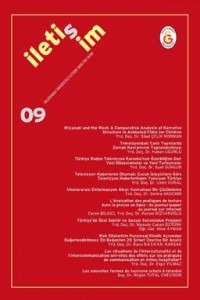Abstract
The communication in hospital has social, psychological, economic, informative and organisational purposes. But it is also registered in the middle of the therapeutic process. In this study, our aim is not to give receipts on the efficient communication way, but to understand how the communication interactions in very different situations are realised. This interpersonal communication process between doctor and patient has, also, a heterogeneous characteristic in interculturality. This allows to have access to the medical care by supporting the communication and the comprehension between all the medical professionals and the foreign patients. Therefore, to question "the therapeutic word" which is specific to the doctor-patient relation, is selected as the research method with a comparative study undertaken in France and in Turkey with 175 patients, around three axes as the interaction between the doctors and in-patients, that in the doctor's office and that in the consultation room. Our main objective was to be able to analyse which was the function of the therapeutic word in these various international models in hospital.
Keywords
Les situations de l'interculturalité et de l'intercommunication ont-elles des effets sur les pratiques de communication en milieu hospitalier?
Abstract
La communication en milieu hospitalier a une finalité sociale, psychologique, économique, informative et organisationnelle. Mais elle s'inscrit également au coeur du processus thérapeutique. Dans ce travail, on ne vise pas à faire des recettes sur la façon de bien communiquer, mais de comprendre comment se jouent les interactions communicationnelles dans des situations très différentes. Ce processus de communication interpersonnelle entre médecin et patient a, aussi, une caractéristique hétèrogène dans l'interculturalité. Ceci vise à permettre l'accès aux soins médicaux en favorisant la communication et la compréhension entre tous les professionnels de l'hôpital et les patients étrangers ou d'origine étrangère. Pour ce faire, interroger "la parole thérapeutique" spécifique à la relation médecin-patient, est choisi comme méthode de recherche du travail avec une étude comparée menée en France et en Turquie sur 175 patientes, autour de trois axes en tant que l'interaction entre les médecins et les patients hospitalisés, celle dans le cabinet médical et celle dans la salle de consultation. Notre principal objectif a été de pouvoir analyser la fonction de la parole thérapeutique dans ces différents modèles internationaux en milieu hospitalier entre les soignants et les soignés interculturels.
Abstract
Hasta ile hekim arasındaki iletişimde; karşılıklı iyi bir ilişkinin kurulması, bilgi transferi ve tedavi ile ilgili karar verme gibi farklı amaçlar bulunmaktadır. Son yıllarda sıklıkla hekim-hasta arasında bir ortaklık kurulması felsefesinden de bahsedilmektedir. Ancak, hastane ortamında uzmanlarla hastalar arasındaki iletişim süreci, hastanenin, idari ve tıbbi kadroları bir arada bulundurmasından kaynaklanan karmaşık bir yapı olması nedeniyle, oldukça zor ve çok boyutludur. Bu sürecin tıbbi pratiklerin uygulanması süresine de etkileri olmaktadır. Hasta tatmininin önemli öğelerinden biri olan doktor-hasta ilişkisi hem doktor hem de hasta bakış açısıyla incelenmesi gereken bir konudur. Bu çalışmada öncelikle doktor-hasta ilişkisinin analiz edilebileceği genel bir çerçeve sunmak amacıyla teorik bilgiler sunulmakta daha sonra da Türkiye'de ve Fransa'da jinekoloji kliniğine başvuran toplam 175 kadın hasta ile iletişim ve kültürlerarası farklılığın değerlendirildiği bir araştırmanın sonuçları genellemeler üzerinden sunulmaktadır.
Details
| Primary Language | Turkish |
|---|---|
| Authors | |
| Publication Date | April 1, 2008 |
| Published in Issue | Year 2008 Issue: 9 |



